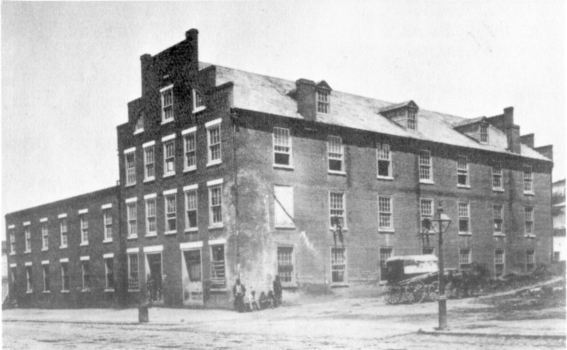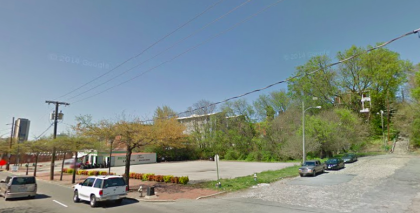RECENT COMMENTS

Main Street Hospital for slaves
On the northwest corner of 26th and East Main streets, just below the stairs leading to East Franklin Street, there is an empty lot that once was home to a building with an unusual history.
Built as a tobacco factory for Washington B. Ross, it was an imposing, three story brick structure with a step-gable roof, oriented toward 26th Street. It was just one of the many tobacco factories along East Main and East Cary in area at the bottom of Church Hill.
By late 1860, however, the Ross Factory had been renamed Main Street Hospital and became a hospital for the enslaved. Although slaves could be committed to asylums for mental illness at their owner’s expense, medical hospitals were quite unusual, not only in Virginia, but in all of the South.
The Main Street Hospital was advertised in the Richmond Dispatch on November 3, 1860:
MAIN STREET HOSPITAL FOR SLAVES. – This Hospital is situated near the corner of Main and 26th streets, and is admirably adapted in airiness, privacy and healthfulness of position, to the purposes for which it has been instituted, namely: MEDICAL, SURGICAL and OBSTETRICAL treatment of SLAVES. – The rules and regulations governing this institution have already been published. A circular containing full particulars will be furnished those who may desire further information.
TERMS. – Patients per week, $5; less than a week, $1 per diem; but the aggregate shall not exceed the charge for a full week. Patients attending the daily examinations (not fit subjects for HOSPITAL CONFINEMENT,) charged the regular fee adopted by the profession at large. – The above charges include board, medicine, medical attendance and nursing. Surgical operations charged according to rules of other Hospitals of the city. For further information apply to the Physician resident at the Hospital, or to either of the undersigned Physicians and Proprietors.
The hospital was run by doctors Peachy, Hancock and Vest, and was advertised periodically through late 1860 and into 1861.
This unusual hospital was not long lived. The Civil War broke out in April of 1861, and hospitals, tobacco factories, schools, hotels, and many other large buildings in Richmond were pressed into service for wounded soldiers of both armies, as well as prisons to house Union POWs.
In August 1861, the Dispatch announced that the Ross Factory was now one of the hospitals for “several hundred wounded Abolition soldiers” which had poured into Richmond. With too many sick and wounded Union soldiers to fit into the General Hospital, Ross Factory Hospital, as it was usually known during the war, became the next place where they were housed.
Drs. Peachy, Hancock, and Vest stayed on and ministered to the Union soldiers as they had to slaves, with the addition of seven Union doctors. By 1864, the hospital was housing some 300 soldiers.
After the war, the building reverted to a tobacco factory. It was extant until at least 1925, although the 1950 Sanborn fire insurance map shows that it was no longer standing.
PHOTO (TOP) 1865 from the Library of Congress
— ∮∮∮ —







There were many Civil War hospitals as well, some falling within Church Hill residential areas like:
The “Company G Hall” Capt. Gordon’s Company, in 1860 turned hospital in 1861. By order of F. Sorrell in August 1862, existing hospitals were re-designated with General Hospital Numbers and this became GH #27. It closed in April 1863. Was nicknamed Gangrene Hospital and was the Tennessee hospital. The location has been somewhat off in descriptions and on the map it shows to be on the East side of 28th Street midway between M and N Streets. When it was built as a armory and drill room on the corner of 28th and N and was 96-feet by 45-feet in footprint. That would be where the Ethel Baily Furman Park by the George Mason Elementary School is today. It was demolished by 1867.